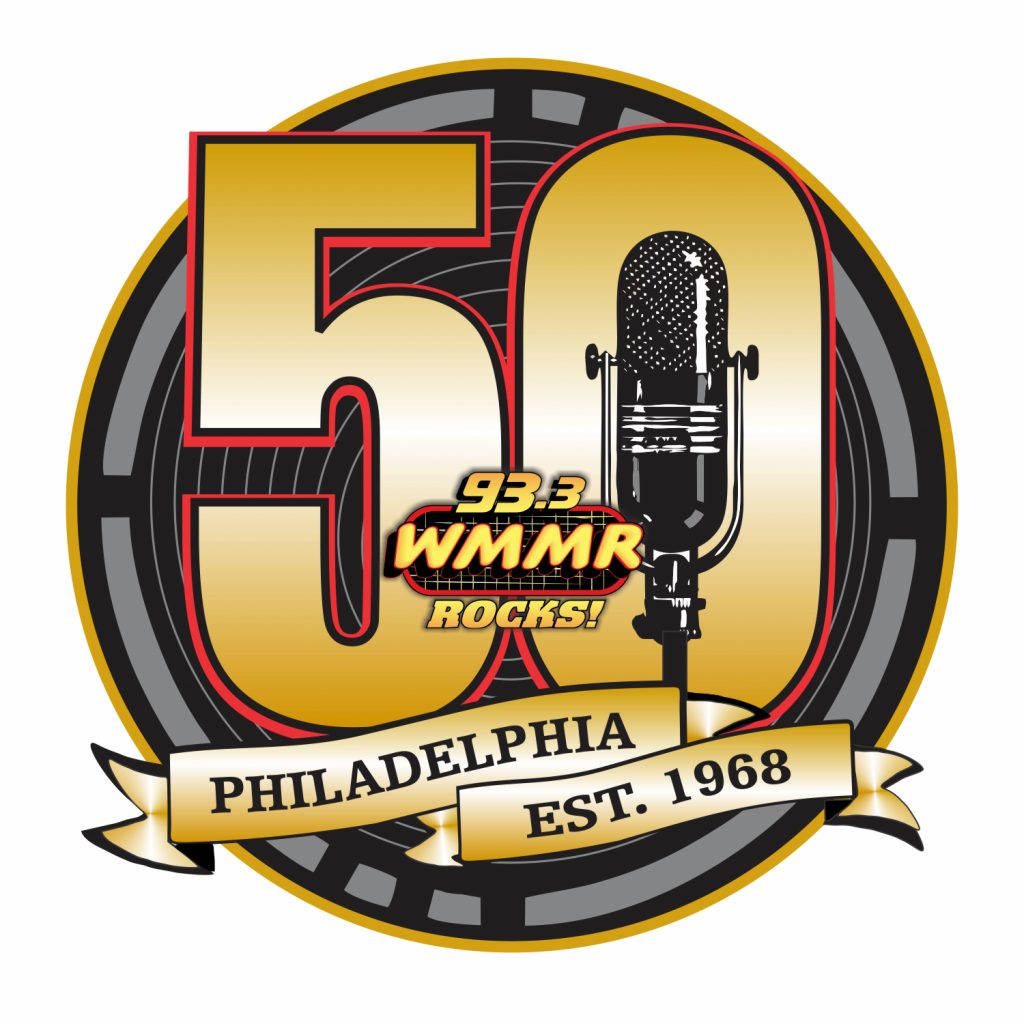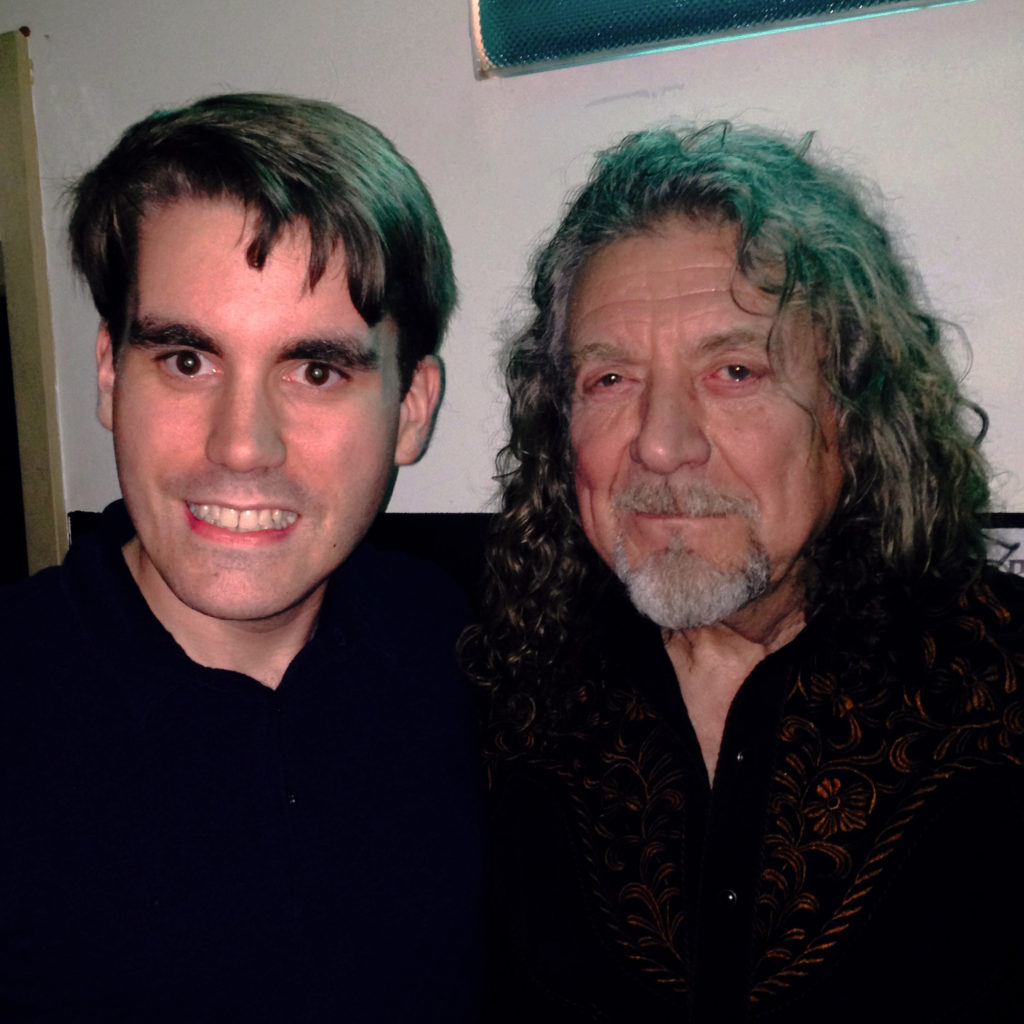I was reminded of that reality last week during a conversation with Jeff Penfield, APD/Director of Digital for Sky Daniels’ Triple A station in L.A., 88.5 KCSN. Penfield is a human case in point. A veteran of Emerson’s college WERS and a Boston native, Jeff is a wise-beyond-his-years 31 year-old – and he knows Rock and Classic Rock music better than me. That’s him pictured at the top of this post, hanging out with Zeppelin’s Robert Plant – who happens to be four decades older than Jeff. But who’s counting?
We were having a philosophical chat about the state of music in 2018 – 88.5 listeners are voting on the best songs from the year – and the conversation inevitably turned to the multi-generational power of nostalgia. Jeff believes Classic Rock has thrown a monkey wrench into the time/space continuum of music. In fact, perceptual and music research often reveal even stronger appeal of core artists like the Doors, Zeppelin, and Hendrix among the youngest slice of the demographic spectrum.
Some of you remember those “slide rules” where you could look up the age of a target listener, and then link it up to his/her formative years for music. That used to be a pretty good barometer of music tastes – until now.
Not surprisingly, radio and its important personalities played a huge role in what he listens to today. Here’s how Jeff explains it:
“Classic Rock was one of a few factors that make the “no music before 19__” less important. Kids can scan the radio dial and

land on options for music that aren’t new. A kid like myself grew up with Charles Laquidara (on BCN) and Carter Allan on WZLX in Boston and become a huge Led Zeppelin, Aerosmith, and Who fan.
“As far as radio is concerned, Classic Rock, Oldies, and Classic Hits provide an outlet for discovering and loving older music that (as far as I know) didn’t really exist before those formats were developed.”
But for Jeff, it goes beyond radio. Technology has changed the equation about how and when consumers are exposed to the music they end up becoming passionate about:
“A couple of other factors came into play too. Napster completely changed the game. I was in middle school when it came out and you could get anything. There was no rack of new music at the record store in your face, it was everything you could ever want at your fingertips. My music collection could include Cream and The Beatles alongside Red Hot Chili Peppers and Foo Fighters.”
But to unlock the other factors that come into play, changing the game on music’s generation appeal is new technology as well as some of the pop culture factors mentioned in yesterday’s post:
“Sky (Daniels) always brings up (the games) “Rock Band” and “Guitar Hero,” too. Those were mostly classic rock and 90s rock songs. This was yet another way younger generations were introduced to older music.
“Then you add in movies (both classics and newer releases with soundtracks like ‘Guardians Of The Galaxy’), TV shows, and other syncs, and the music is still being introduced. Streaming and iTunes brought a digital version of the record store’s new music rack with featured playlists and charts, but there’s still endless possibilities to discovering thousands of bands from any era through those services.
“I think all of those opportunities made an impact on what music is consumed by my generation. The radio and music of the 60s and 70s was incredible. Classic Rock and Classic Hits kept it alive and so we see unexpected demos connecting with it. A Millennial like me can have a favorite band that broke up 7 years before I was born. Our current media environment proves time and time again – get what you want when you want it. That includes older content.”
Wise words from someone who was born the year Guns N’ Roses’ “Appetite For Destruction” was released.
 It’s interesting that many Boomers take credit for their kids’ appreciation because it was always on in the house or they took their offspring to concerts and shows. As Jeff Penfield well knows, the nostalgic wave among Millennials runs much deeper than that. I can tell you that Puccini, Brahms, “South Pacific,” and Doris Day were on in my house growing up, and I never listen to any of it today.m
It’s interesting that many Boomers take credit for their kids’ appreciation because it was always on in the house or they took their offspring to concerts and shows. As Jeff Penfield well knows, the nostalgic wave among Millennials runs much deeper than that. I can tell you that Puccini, Brahms, “South Pacific,” and Doris Day were on in my house growing up, and I never listen to any of it today.m
Here’s the difference: Classic Rock and Oldies from the 60s and 70s strongly connect with today’s music, whether it’s Hip-Hop samples from hit songs or the many different exposure points for the music throughout the pop culture landscape.
In much the same way kids back in the 60s and 70s made a statement about themselves whether they loved the Beach Boys or worshiped the MC5, today’s youth also use music to communicate and symbolize who they are. And increasingly, they’re using artists and albums from decades ago to define themselves.
What does that mean for radio in 2019?
Just a few years back, we used to advise heritage radio stations to go easy on celebrating big anniversaries to avoid making themselves sound old. But now, a 40th anniversary for KUPD or a 50th for MMR is a great excuse to dust off past milestones and accomplishments, appreciated by original audience members and respected by its newer ones.
now, a 40th anniversary for KUPD or a 50th for MMR is a great excuse to dust off past milestones and accomplishments, appreciated by original audience members and respected by its newer ones.
When I hear people waxing nostalgic about the good old days of radio, I realize the warm glow simply intensifies with each passing year. There’s a tendency to glorify the past, whether you actually experienced it or not. And the further those days are in the rear-view mirror, the more romantic they become.
More and more of these milestone celebrations for radio are lasting for months and months as listeners seemingly never tire of honoring the past – the great music, the iconic DJs, and a station’s impact on their local community. “Back in the day” has become a badge of honor, whether you are old enough to have lived the experience in real time or you’re young and wish you had.
The fact that many radio stations are steeped in nostalgia shouldn’t be a blot on a station’s brand. If anything, it’s a symbol of commitment, survival, quality and class. Whether it’s going back into a station’s vault or playing back a great artist interview, broadcast sales people should be demanding top dollar for adult and Millennial demographics that can all coalesce music that’s stood the test of time.
Right now, we’re in the heart of radio’s annual Christmas music pig-out, a two month celebration that drips in emotion, memories, and family. This now-annual leap backwards into the past is another indication of just how powerful the pop culture nostalgia movement is for radio.
So, here’s the twist on the iconic saying in the all-time classic, “It’s A Wonderful Life”…
“Every time you hear an oldie or a classic, a cash register is ringing somewhere.”
The sound should be echoing inside radio buildings all over America. It should be a reminder that cashing in on the past is a core tenet of pop culture appeal. It should be a reliable and consistent part of every radio company’s business model, just as Netflix, Hulu, SiriusXM, and even streamers Spotify and Pandora invest heavily in its intrinsic financial value.
Radio paved the way for this nostalgic profiteering by being everybody’s soundtrack for this music – then and now.
Broadcasters should be embracing it and figuring out ways to optimize it – not running away from it.
- What To Do If Your Radio Station Goes Through A Midlife Crisis - April 25, 2025
- A 2020 Lesson?It Could All Be Gone In A Flash - April 24, 2025
- How AI Can Give Radio Personalities More…PERSONALITY - April 23, 2025





Bingo! Audio Recall for Our Soundtrack. Excellent!
One other on-ramp here might be Young Country.
Lot’s of peer-pressured people in their 20’s and 30’s tuned in and filled summer sheds for guitar-driven songs were basically just twanged-up versions of what rock was in the seventies.
Their next stop:
Eagles “Greatest Hits”
Natural segue.
That it is, Marty. Thanks for the insightful comment.
Great piece Fred
One other factor here that might explain why the biggest Classic Rock bands endure…their image is often frozen in time, and usually frozen at or near their peak.
For every Stones & Springsteen or McCartney that age openly in public…most Classic Rock bands work hard to keep a tightly controlled set of imagery focused around their peak years …think of all the imagery still used by Led Zep, AC/DC, The Doors, Pink Floyd etc.
Those logos, iconic pics, and LP covers defy aging…
Interesting “take,” Jack. Having those images sealed is a real advantage for bands that have passed on or certainly aged. The symbolism on album covers and other visuals live on long after these artists have left this earth.
Fascinating take on this phenomenon. My sense is that in addition to all of the movie/tv/commercial/video game use of these songs the fact that they have never been off the radio impacts their longevity. These songs were released in the 60s, 70s and 80s and from the day they started receiving airplay, they have never gone away. Stairway to Heaven, Sweet Child O’ Mine and Hey Jude have been on the radio every day since their earliest spins. This is the first body of music that has ever received this kind of exposure.
Spot on, David. I had not thought about this from a continuous radio airplay POV. When I read your comment, I thought about Glenn Frey’s comment in that great Showtimes doc about the Eagles. Even when the Eagles broke up and were off the radar, Classic Rock radio continued to play their catalogue, making it easy to regroup (and cash in) for the “Hell Freezes Over” tour years later.
Every station owner, manager and programmer should read this and in the process understand that we “classic” stations are no longer just in the 35-54 business, and that Madison Avenue’s continued willingness to write off the 55+ audience is NOT a death knell.
I knew this even as a teenager in the 1970s. Even though I appreciated Led Zeppelin, the Four Tops, and Elvis Presley, I also liked Glenn Miller, the Statler Brothers, and Engelbert Humperdinck. (People would be astonished at the variety of genres among the 2200+ tracks on my personal MP3 player.)
If we aren’t including P1 and P2 listeners from outside our “target demographic” in music testing, this article tells us why we should.
KM, thanks for the reinforcement. From radio to advertising, rethinking basic tenents of maarketing in this new media environment is table stakes.
Insightful and hello fellow Emersonian!!!!
It’s obviously a great training ground. I spoke at Dan Vallie’s National Radio Talent Institute at Emerson College earlier this year & enjoyed the experience a lot. Thanks, Max.